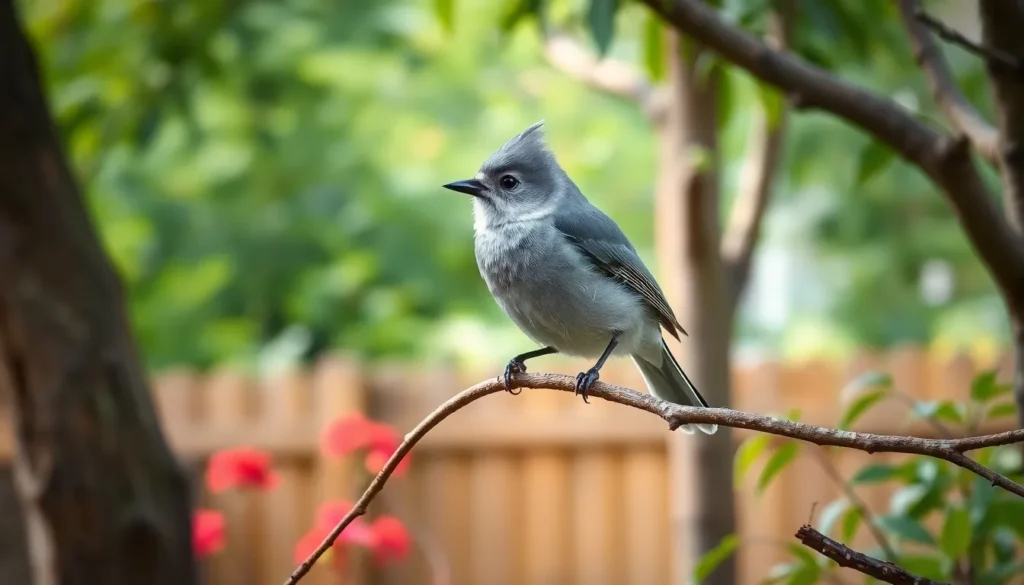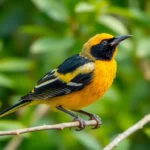We’ve all spotted those adorable little gray birds flitting through our backyards, but many of us don’t realize we’re watching one of North America’s most charming residents – the titmouse. These small songbirds pack incredible personality into their compact frames, captivating birdwatchers with their acrobatic feeding habits and distinctive crested heads.
What makes titmice truly fascinating isn’t just their cute appearance – it’s their remarkable intelligence and social behavior. We’ll discover how these clever birds cache thousands of seeds each fall, remember exact locations months later, and communicate through complex calls that vary by region.
Whether you’re a seasoned birder or simply curious about the wildlife visiting your feeder, understanding titmouse behavior will transform how you observe these delightful creatures. Let’s explore everything that makes these feathered acrobats so special and learn why they’ve earned their place as backyard favorites across the continent.
What Is a Titmouse Bird
A titmouse bird belongs to the family Paridae, comprising small songbirds renowned for their acrobatic abilities and curious nature. These compact creatures measure between 4 to 6.5 inches in length and weigh approximately 0.6 to 1.1 ounces. North America hosts six distinct titmouse species, with the Tufted Titmouse being the most widely recognized across eastern regions.
Physical characteristics define titmouse birds through several distinctive features:
- Gray or brown upperparts with lighter underparts
- Short necks connecting proportionally large heads
- Small black beaks perfectly adapted for seed cracking
- Round dark eyes that enhance their alert expressions
- Compact bodies built for agile movement through branches
Habitat preferences showcase the titmouse’s adaptability across various environments. Deciduous forests provide their primary nesting grounds, while mixed woodlands offer abundant food sources. Suburban areas attract these birds due to mature trees and backyard feeders. Oak and hickory forests support large titmouse populations through consistent acorn and nut availability.
Behavioral traits distinguish titmice from other small songbirds through their intelligence and social dynamics. They cache thousands of seeds annually, remembering storage locations with remarkable accuracy. Flocking behavior occurs during winter months when multiple family groups unite for foraging expeditions. Acrobatic feeding displays include hanging upside down from branches and performing aerial maneuvers to reach food sources.
Scientific classification places titmouse birds within the order Passeriformes alongside other perching birds. The genus Baeolophus contains five North American species, while Poecile includes the Bridled Titmouse. Taxonomic studies reveal close relationships between titmice and chickadees, sharing similar ecological niches and behavioral patterns.
Physical Characteristics of Titmouse Birds
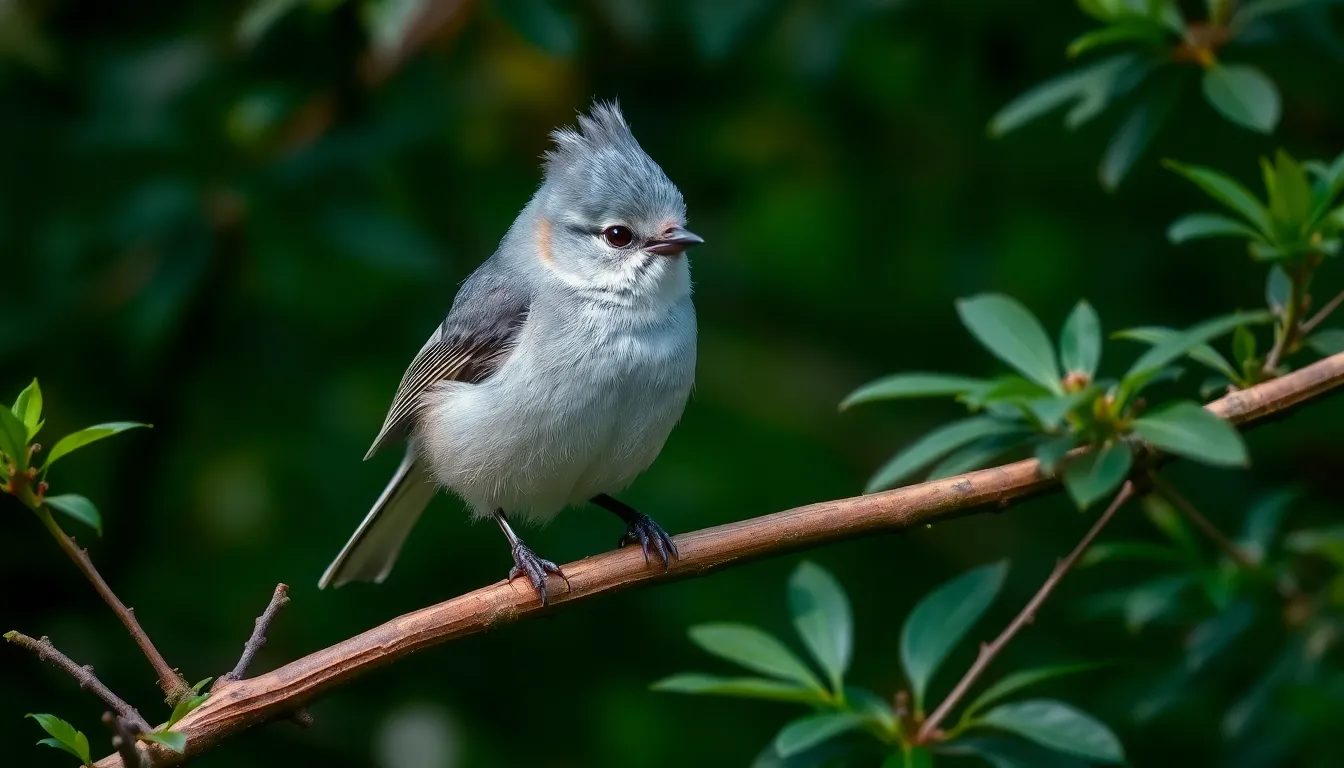
Physical characteristics define titmouse birds as compact songbirds with distinctive features that make them instantly recognizable in North American environments. These small birds showcase remarkable consistency across species while maintaining unique identifying traits.
Size and Build
Titmice measure between 4 to 6.5 inches in total length with compact body structures optimized for agility. Adult birds weigh approximately 0.6 to 1.1 ounces, making them lightweight yet sturdy enough for acrobatic feeding behaviors. Their bodies feature short necks that connect proportionally large heads to rounded torsos. Wings span 7.9 to 10.2 inches across, providing excellent maneuverability through dense foliage and branches.
Body proportions create a distinctive silhouette with legs positioned for gripping bark surfaces and small twigs. Feet contain strong claws that enable hanging upside down while foraging, a signature titmouse feeding position. The streamlined build allows rapid directional changes during flight and quick movements between perches.
Coloring and Markings
Titmouse species display consistent gray or brown upperparts with lighter underparts ranging from white to pale gray. Flanks often show rusty orange or buff coloring, particularly prominent in Tufted Titmice during breeding season. Back feathers create smooth gradations from darker crowns to lighter rumps.
Facial markings include distinctive black patches around small beaks, extending minimally toward the eyes. Some species exhibit subtle streaking patterns on wings and tails, though these remain less pronounced than other songbird families. Juvenile birds show slightly duller coloring compared to adults, with less defined contrast between upper and lower body regions.
Distinctive Features
Crested heads represent the most recognizable titmouse feature, with pointed tufts extending 0.5 to 1 inch above the skull. Round dark eyes appear proportionally large relative to head size, providing excellent vision for detecting predators and food sources. Small black beaks measure approximately 0.4 to 0.6 inches in length, perfectly adapted for extracting seeds from cones and crevices.
Short tails typically span 1.6 to 2.4 inches, featuring slight notching at the tips. Leg coloring varies from dark gray to black, with scales providing grip on various surfaces. Wing patterns include subtle darker flight feathers that become visible during extended flight sequences, though these remain less conspicuous than body coloring overall.
Different Types of Titmouse Species
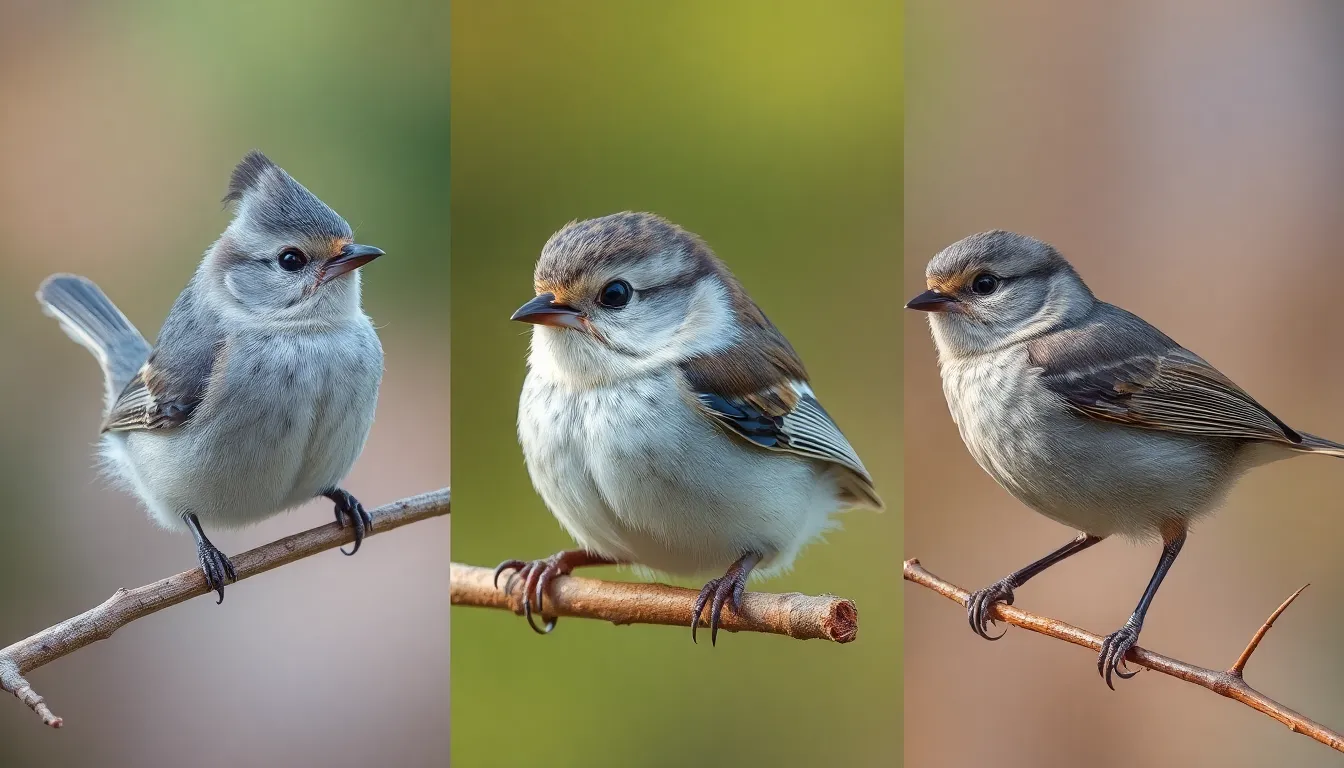
North America hosts six distinct titmouse species, each adapted to exact regional habitats and environmental conditions. We examine the three most recognizable species that demonstrate remarkable diversity within this fascinating bird family.
Tufted Titmouse
Tufted Titmouse (Baeolophus bicolor) represents the most widespread and recognizable species across eastern North America. Gray upperparts and whitish underparts create their classic appearance, while the prominent pointed crest distinguishes them from other small songbirds. These birds measure 5.5 to 6.3 inches in length and weigh between 0.6 to 0.9 ounces.
Eastern deciduous forests from southern Canada to northern Florida provide their primary habitat range. Mixed woodlands, parks, and mature suburban landscapes support stable populations throughout their territory. Tufted Titmice cache up to 50,000 seeds annually in bark crevices and tree cavities for winter survival.
Black button eyes and small dark beaks complement their compact body structure optimized for acrobatic feeding behaviors. Rusty orange flanks appear on some individuals, particularly those in southern populations. Their distinctive “peter-peter-peter” call echoes through forest canopies during breeding season from March through July.
Bridled Titmouse
Bridled Titmouse (Baeolophus wollweberi) displays unique facial patterns that create distinctive “bridle” markings across their head and face. Black lines curve around white cheeks and extend from the bill through the eye, creating an unmistakable facial design. These southwestern specialists measure 4.3 to 5.2 inches in length and weigh approximately 0.3 to 0.4 ounces.
Mountain forests of Arizona, New Mexico, and western Texas contain their primary breeding territories. Oak and pine woodlands at elevations between 5,000 to 9,000 feet support year round populations. Mexican populations extend their range southward through mountainous regions of Sonora and Chihuahua.
Pointed crests and gray brown upperparts match the Tufted Titmouse’s basic structure, though Bridled Titmice appear notably smaller and more compact. Complex social behaviors include mixed species flocking with other highland birds during winter months. Their high pitched calls and rapid “chick-a-dee-dee” notes distinguish them acoustically from eastern relatives.
Oak Titmouse
Oak Titmouse (Baeolophus inornatus) inhabits California’s oak woodland ecosystems from sea level to 6,500 feet elevation. Plain brown gray plumage lacks the distinctive markings found in other titmouse species, earning them their “inornatus” scientific designation meaning “plain.” These birds measure 5.2 to 5.9 inches in length and weigh between 0.5 to 0.7 ounces.
California oak savannas, chaparral scrublands, and mixed evergreen forests provide essential habitat requirements throughout their range. Coast live oak, valley oak, and blue oak trees supply critical nesting sites and food sources. Year round residents rarely migrate beyond their established territories, showing strong site fidelity to exact oak groves.
Subtle variations in plumage tone distinguish regional populations, with coastal birds appearing slightly darker than inland subspecies. Acorns comprise up to 60% of their annual diet, making them highly dependent on oak tree productivity cycles. Their monotonous “tsick-a-dee-dee” calls lack the musical quality of eastern Tufted Titmice, reflecting their more arid habitat adaptations.
Natural Habitat and Distribution
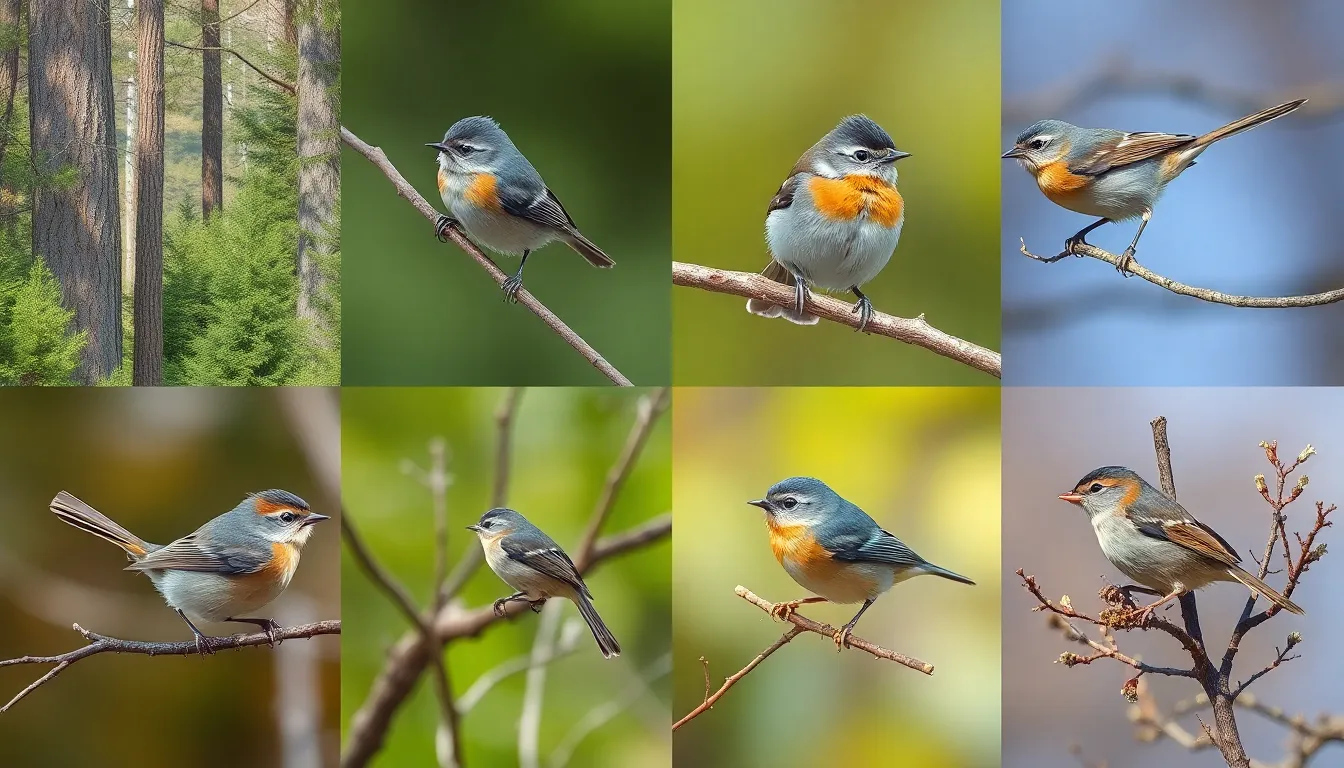
Titmouse birds occupy diverse habitats across North America, with each species adapting to exact environmental conditions and geographic regions. These adaptable songbirds demonstrate remarkable flexibility in their habitat selection while maintaining distinct distribution patterns.
Geographic Range
Tufted Titmouse populations span the eastern United States from southern Maine to northern Florida, extending westward to Nebraska and eastern Texas. Oak Titmouse distribution centers in California’s Central Valley and coastal ranges, with populations reaching from southern Oregon to Baja California. Bridled Titmouse ranges concentrate in southwestern mountain regions including Arizona, New Mexico, western Texas, and northern Mexico.
Juniper Titmouse inhabits the Great Basin and Colorado Plateau regions across Nevada, Utah, Colorado, and parts of California and Arizona. Black-crested Titmouse populations occupy central and southern Texas, extending into northeastern Mexico. Plain Titmouse historically referred to populations now classified as Oak and Juniper Titmice following taxonomic revisions in 1996.
Geographic ranges reflect each species’ adaptation to distinct climate zones and elevation preferences. Elevation distributions vary significantly among species, with some preferring lowland areas while others thrive at altitudes exceeding 8,000 feet. Range expansions occur gradually as habitat conditions and climate patterns shift over decades.
Preferred Environments
Deciduous forests provide optimal habitat for Tufted Titmice, particularly areas dominated by oak, hickory, maple, and beech trees. Mixed woodland environments support diverse titmouse populations through varied food sources and nesting opportunities. Suburban areas with mature tree coverage attract titmice seeking abundant feeding stations and reduced competition.
Oak woodlands serve as primary habitat for Oak Titmice, where acorn availability directly influences population density and breeding success. Pine-oak forests in mountainous regions support Bridled Titmice at elevations between 5,000 and 9,000 feet. Juniper woodlands and pinyon-juniper forests provide essential habitat for Juniper Titmice across arid western landscapes.
Riparian corridors enhance habitat quality by offering water sources, diverse insect populations, and nesting materials. Park environments and large gardens replicate natural woodland conditions while providing supplemental feeding opportunities. Tree density requirements vary by species, with most preferring canopy coverage between 40% and 80% for optimal foraging and protection.
| Species | Primary Habitat | Elevation Range | Key Tree Species |
|---|---|---|---|
| Tufted Titmouse | Deciduous forests | 0-3,000 feet | Oak, hickory, maple |
| Oak Titmouse | Oak woodlands | 0-6,000 feet | Coast live oak, valley oak |
| Bridled Titmouse | Pine-oak forests | 5,000-9,000 feet | Ponderosa pine, Gambel oak |
| Juniper Titmouse | Pinyon-juniper forests | 3,000-8,000 feet | Utah juniper, pinyon pine |
Behavior and Social Patterns

Titmouse behavior showcases remarkable intelligence and adaptability that distinguishes these birds from other small songbirds. Social patterns among titmice vary seasonally, with complex flocking dynamics during winter months and territorial behaviors during breeding season.
Feeding Habits
Titmice demonstrate exceptional foraging intelligence through their acrobatic feeding techniques and food caching behaviors. These birds commonly hang upside down from branches to access insects and seeds that other species can’t reach. Oak Titmice consume up to 60% acorns in their diet, while Tufted Titmice prefer a more varied menu including insects, seeds, and berries.
Caching behavior represents one of the most fascinating aspects of titmouse feeding patterns. Individual Tufted Titmice store between 40,000 to 50,000 seeds annually in bark crevices and tree holes. Memory capabilities allow them to relocate cached food items with 80% accuracy even months later. Winter feeding patterns shift toward cached reserves when natural food sources become scarce.
Foraging strategies differ among species based on habitat preferences. Bridled Titmice focus on pine seeds and insects found in coniferous forests, while Oak Titmice rely heavily on acorns from their woodland habitats. Group foraging occurs frequently during autumn and winter, with mixed flocks of 6 to 12 individuals working together to locate food sources.
Nesting and Breeding
Breeding season extends from March through July across most titmouse ranges, with peak activity occurring in April and May. Monogamous pairs typically remain together for entire breeding seasons and often reunite in subsequent years. Cavity nesting characterizes all titmouse species, with pairs excavating holes in dead wood or utilizing existing cavities.
Nest construction takes 6 to 12 days, with both partners contributing materials including moss, bark strips, hair, and feathers. Female titmice lay 3 to 9 eggs per clutch, with most species averaging 5 to 6 eggs. Incubation lasts 12 to 14 days, performed exclusively by females while males provide food delivery.
Fledgling care involves both parents for 15 to 18 days after hatching. Young titmice remain with parents for additional 3 to 4 weeks post-fledging, learning essential survival skills including caching techniques and predator recognition. Second broods occur in southern populations when conditions permit, typically in June or July.
Communication and Calls
Vocal communication among titmice encompasses over 30 distinct call types that serve various social functions. Primary calls include alarm signals, contact notes, and territorial declarations that carry across woodland habitats. Tufted Titmice produce their characteristic “peter-peter-peter” song during breeding season, while Oak Titmice emit harsh “tsick-a-dee-dee” notes.
Contact calls maintain flock cohesion during foraging expeditions, with different frequencies indicating exact messages about food sources or potential threats. Alarm calls vary in intensity based on predator type, with rapid “chick-a-dee” sequences signaling aerial threats and slower notes warning of ground predators. Mixed species flocks rely on titmouse alarm systems, as these birds often serve as sentinels for other woodland species.
Seasonal variation affects calling patterns significantly, with territorial songs peaking during breeding months and social contact calls dominating winter communications. Juveniles learn call repertoires through observation and practice, developing full vocal capabilities within 6 to 8 weeks of fledging.
Attracting Titmouse Birds to Your Yard
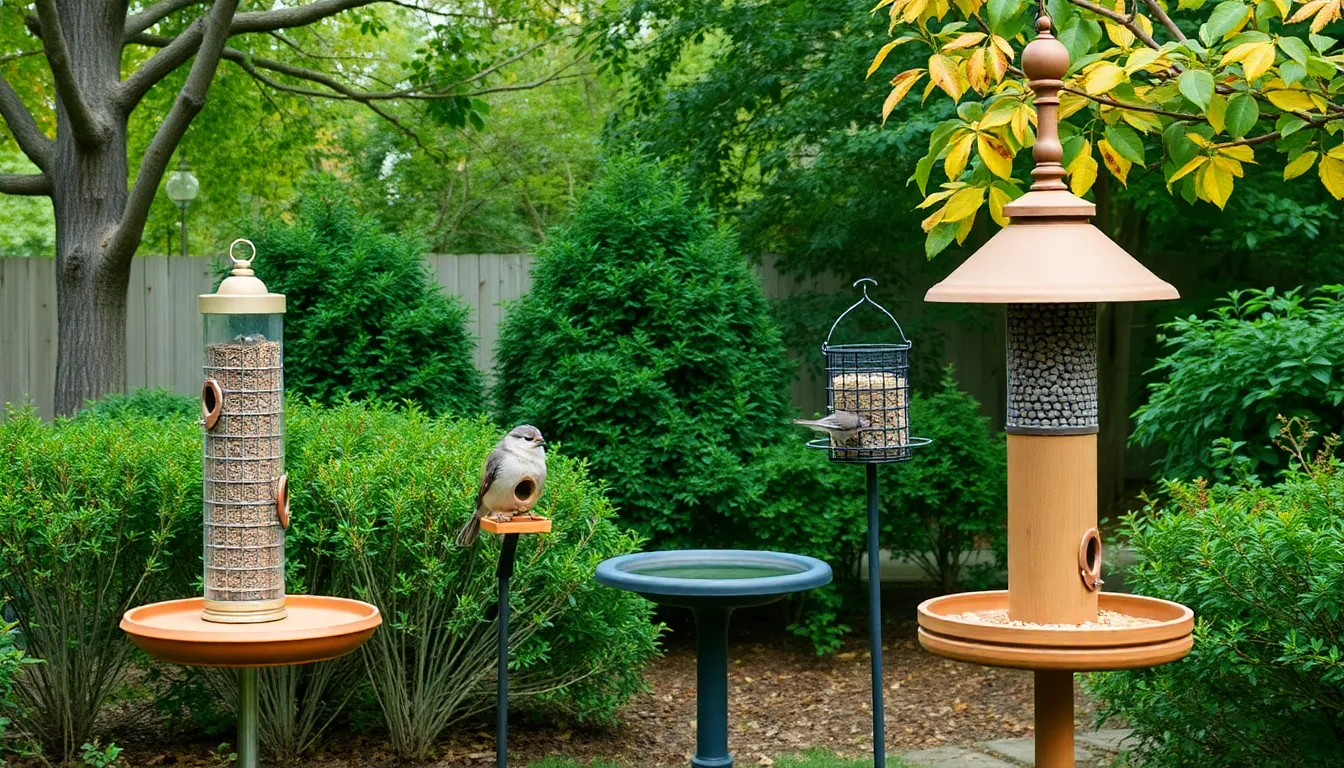
Transforming your backyard into a titmouse haven requires strategic placement of appropriate feeders and creation of suitable habitat conditions. These intelligent songbirds respond positively to exact environmental elements that mirror their natural woodland preferences.
Best Bird Feeders and Food
Tube feeders with metal mesh construction provide optimal access for titmice while accommodating their acrobatic feeding style. Platform feeders positioned 5 to 8 feet above ground offer additional feeding opportunities that complement their natural foraging behaviors.
Sunflower seeds rank as the primary attraction for all titmouse species, with black oil sunflower seeds containing 28% protein content that supports their high energy requirements. Safflower seeds serve as an excellent alternative that discourages squirrels while maintaining titmouse interest. Peanuts and suet blocks provide essential fats during winter months when insects become scarce.
Multiple feeder stations create competition reduction among different bird species visiting your yard. Placing feeders 10 to 15 feet apart prevents territorial disputes while ensuring adequate food access. Nyjer seed feeders attract other small songbirds that often flock with titmice during winter months.
| Food Type | Protein Content | Best Season | Feeder Type |
|---|---|---|---|
| Black oil sunflower seeds | 28% | Year-round | Tube feeder |
| Safflower seeds | 16% | Year-round | Platform feeder |
| Suet blocks | 18% fat content | Fall/Winter | Suet cage |
| Peanuts | 25% | Year-round | Mesh feeder |
Creating Suitable Habitat
Native deciduous trees form the foundation of titmouse-friendly landscapes, with oak, maple and hickory species providing natural nesting sites and insect foraging opportunities. Mature trees measuring 15+ inches in diameter offer the cavity nesting requirements these birds prefer.
Understory plantings create layered habitat structure that mimics natural forest conditions. Dogwood, elderberry and native berry-producing shrubs supply insects and fruits throughout different seasons. Dense shrub plantings positioned 3 to 6 feet from feeding stations provide quick escape routes from predators.
Water sources significantly increase titmouse visitation rates, with shallow birdbaths measuring 1 to 2 inches deep accommodating their bathing preferences. Moving water features such as drippers or small fountains generate sounds that attract birds from greater distances. Year-round water availability through heated birdbaths maintains winter bird populations.
Natural nesting boxes designed with 1.25-inch entrance holes accommodate titmouse specifications while excluding larger competing species. Positioning boxes 5 to 15 feet high on mature trees or poles provides optimal nesting conditions. Cedar or pine construction materials resist weather deterioration while maintaining proper ventilation.
Pesticide elimination creates insect-rich environments that support titmouse dietary requirements during breeding season. Native plant gardens attract moths, caterpillars and other insects that comprise 85% of nestling diets. Leaving dead tree branches provides natural foraging surfaces where titmice can extract insect larvae and pupae.
Conservation Status and Threats
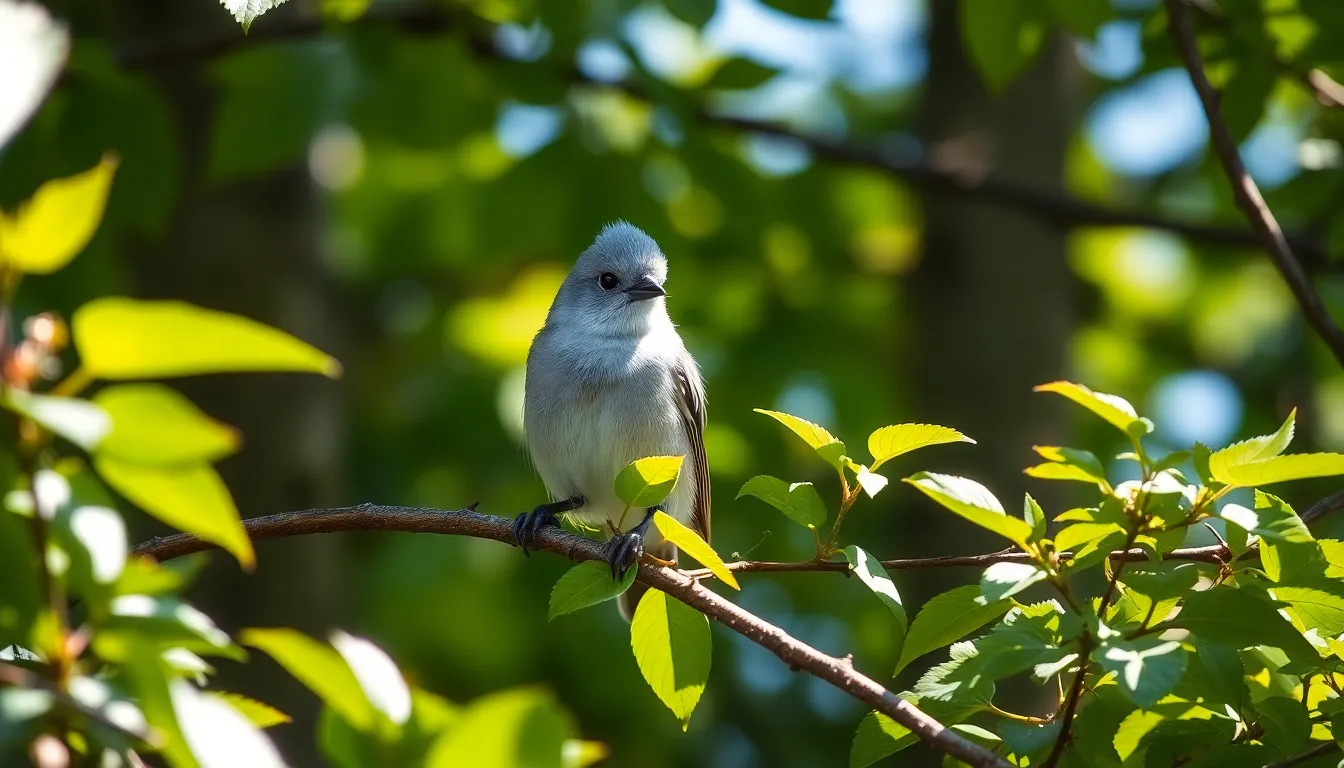
Titmouse populations across North America maintain stable conservation status according to the North American Bird Conservation Initiative. We observe most species listed as “Least Concern” on the International Union for Conservation of Nature (IUCN) Red List, indicating populations remain relatively secure.
Current population trends show mixed results across different titmouse species. Breeding Bird Survey data from 1966 to 2019 reveals the Tufted Titmouse population increased by approximately 1.1% annually, while Oak Titmouse populations declined by 1.8% per year during the same period.
| Species | Conservation Status | Population Trend (1966-2019) | Primary Threats |
|---|---|---|---|
| Tufted Titmouse | Least Concern | +1.1% annually | Habitat fragmentation |
| Bridled Titmouse | Least Concern | Stable | Climate change |
| Oak Titmouse | Least Concern | -1.8% annually | Development pressure |
Habitat loss represents the most important threat facing titmouse populations today. Urban development removes mature deciduous trees essential for nesting and foraging, particularly impacting species like the Oak Titmouse that depend on exact oak woodland ecosystems. Forest fragmentation creates isolated patches that reduce genetic diversity and limit dispersal opportunities for young birds.
Climate change poses emerging challenges for titmouse species distribution and breeding success. Rising temperatures alter food availability timing, potentially causing mismatches between peak insect abundance and nestling feeding periods. Drought conditions in western regions particularly affect Oak and Bridled Titmouse populations by reducing acorn production and water sources.
Invasive species competition threatens titmouse nesting success rates. European Starlings and House Sparrows compete for limited cavity nesting sites, often outcompeting native titmice through aggressive behaviors. Invasive plants like autumn olive reduce native seed and berry availability that titmice depend on during winter months.
Pesticide use in suburban and agricultural areas eliminates insect prey crucial for titmouse reproduction. Parents feed nestlings almost exclusively insects during the breeding season, requiring abundant arthropod populations within their territories. Chemical treatments reduce invertebrate numbers by up to 75% in treated areas.
Window strikes cause important mortality among titmouse populations in residential areas. Studies indicate approximately 365 million to 1 billion birds die annually from building collisions in North America, with small songbirds like titmice particularly vulnerable due to their flight patterns around feeders and water sources.
Cat predation affects ground-foraging titmouse behavior and survival rates. Free-ranging cats kill an estimated 1.3 to 4.0 billion birds annually in the United States, forcing titmice to alter foraging patterns and reducing their feeding efficiency near homes with outdoor cats.
Human activities can positively impact titmouse conservation through targeted habitat management. Creating native plant gardens with oak, hickory and maple trees provides essential nesting sites and food sources. Installing bird-friendly windows with UV-reflective decals reduces collision mortality by 83% according to recent studies.
Citizen science programs like eBird and Christmas Bird Count contribute valuable population monitoring data for titmouse species. These initiatives help researchers track distribution changes and identify conservation priority areas across North America.
Conclusion
We’ve explored the intriguing area of titmice and discovered why these intelligent songbirds captivate birdwatchers across North America. Their remarkable caching abilities social behaviors and acrobatic feeding skills make them truly special backyard visitors.
Creating a titmouse-friendly environment doesn’t require extensive effort. By offering black oil sunflower seeds maintaining water sources and preserving native trees we can support these charming birds while enjoying their delightful presence.
Our collective conservation efforts matter more than ever. Through habitat protection citizen science participation and simple backyard improvements we’re helping ensure future generations will continue to witness the joy these remarkable birds bring to our outdoor spaces.
Frequently Asked Questions
What is a titmouse bird?
A titmouse is a small, charming songbird belonging to the family Paridae, commonly found in North American backyards. These compact birds measure 4-6.5 inches in length and are known for their curious nature, acrobatic feeding abilities, and intelligent behavior including seed caching and complex communication calls.
How many titmouse species are found in North America?
There are six distinct titmouse species in North America. The most recognized is the Tufted Titmouse, along with notable species like the Bridled Titmouse and Oak Titmouse. Each species has unique characteristics and habitat preferences, ranging from eastern deciduous forests to southwestern mountain regions.
What do titmice look like?
Titmice are compact birds with gray or brown upperparts and lighter underparts. They feature short necks, small black beaks, round dark eyes, and distinctive crested heads. Their wings span 7.9-10.2 inches, providing excellent maneuverability. Many species have unique facial markings that help with identification.
Where do titmice live?
Titmice thrive in deciduous forests, mixed woodlands, and suburban areas with mature trees. They prefer habitats with layered vegetation, including understory plantings. Different species have specific preferences: Tufted Titmice favor eastern deciduous forests, while Oak Titmice are adapted to California’s oak woodlands.
What do titmice eat?
Titmice primarily eat sunflower seeds, particularly black oil sunflower seeds. They also consume safflower seeds, peanuts, insects, and suet. During breeding season, they increase their insect intake for protein. These intelligent birds cache thousands of seeds annually for winter storage.
How can I attract titmice to my backyard?
Install tube feeders with metal mesh and platform feeders 5-8 feet above ground. Offer black oil sunflower seeds as the primary food source. Plant native deciduous trees, provide shallow water sources like birdbaths, and eliminate pesticides. Creating layered habitat with mature trees and understory plants is essential.
Are titmice social birds?
Yes, titmice are highly social birds. They exhibit flocking behavior during winter months, often joining mixed-species flocks with chickadees and other small songbirds. They communicate through complex calls and demonstrate intelligent behaviors like cooperative foraging and territorial defense during breeding season.
What threats do titmice face?
Titmice face several threats including habitat loss from urban development, climate change affecting food availability, competition from invasive species, and pesticide use reducing insect prey. Additional threats include mortality from window strikes and cat predation, though most species maintain stable populations.
How can I help with titmouse conservation?
Support titmouse conservation by creating native plant gardens, installing bird-friendly windows, and participating in citizen science programs like eBird and Christmas Bird Count. Eliminate pesticide use, provide natural nesting sites, and maintain mature trees in your landscape to support local populations.

